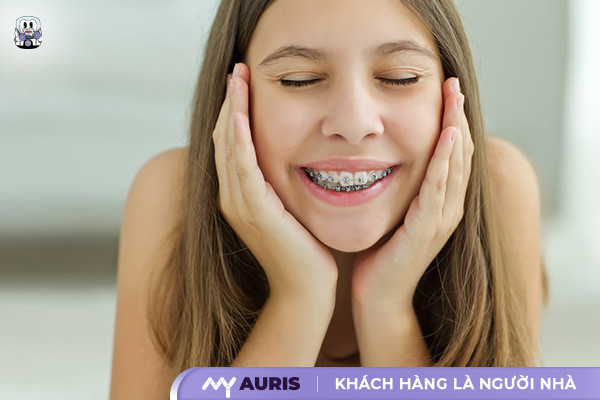Braces for children not only help improve facial aesthetics but also play a crucial role in preventing oral diseases. When braces are applied early, dentists have more time to adjust the teeth, facilitating the treatment process and increasing the likelihood of achieving an ideal bite.
The “Ideal” Time for Children’s Braces
When should children get braces? According to dentists, the ideal time for braces is within two years after a child starts puberty, typically between 12 and 16 years old. This is the stage when the jawbone is still developing, making the bracing process easier and more effective. By getting braces at this age, children can achieve a standard bite, reduce the wearing time, and minimize the need for tooth extractions.
Benefits of getting braces between 12 and 16 years old:
- Jawbones are not yet fixed, making it easier to guide teeth into desired positions.
- No tooth extraction needed for cases of underbite or crowded teeth.
- Shortens the bracing period, providing quick aesthetic results.
- Maintains long-term results, reducing the need for retainers in adulthood.
After the bracing process is completed, the child’s permanent teeth, gums, and jawbones continue to change. Girls may continue to develop until age 16, while boys may do so until age 18. Therefore, parents need to monitor their child’s oral health to promptly detect any abnormalities, helping to maintain stable orthodontic results.

Should Children Get Braces? What is the Appropriate Time?
Dentists are often the first to detect a child’s oral health issues, such as chipped teeth, crowded teeth, crooked teeth, or crossbite (overbite, underbite). When indicated by the dentist, parents should consider early orthodontic treatment for children to ensure the best possible orthodontic outcomes.
Typically, the ideal age for braces is between 8 and 9 years old, when the jaw is developing and not all primary teeth have been replaced. In cases where a child has a malocclusion, early intervention is needed before the first primary tooth is lost. If delayed too long, jawbone development can be affected, making the orthodontic process more complex.
How Long Can Children’s Orthodontic Treatment Last?
The duration of children’s orthodontic treatment depends on their oral condition and the bracing method used. Some children only need to wear brackets and archwires for a few months, while others may require 1 to 3 years. However, because a child’s jaw is still developing, teeth move more easily than in adults, making children’s orthodontics faster and more effective.
After completing orthodontic treatment, parents should ensure their child wears a retainer to prevent tooth shifting and ensure long-lasting results. If the child is young, dentists advise parents to remind them to follow instructions to avoid affecting treatment effectiveness.

Children’s Braces Procedure: Important Steps to Know
Children’s braces are an orthodontic process that helps reshape the dental arch, improve the bite, and provide a confident smile. Below are the steps in the bracing procedure that orthodontists perform to ensure the highest effectiveness.
The orthodontist will attach brackets to the front surface of the teeth, then connect them with archwires to create traction that gradually moves the teeth into the desired position.
Every 4-6 weeks, the child will be examined and have their archwires changed to ensure the bracing process proceeds as planned. In some cases, the child may also need to use:
- Orthodontic elastics (Elastic bands): Elastic bands help connect the upper and lower teeth, creating traction to adjust tooth positions more precisely.
- Headgear: A metal frame with supports wrapped around the head, which helps pull the front teeth backward, often used for overbite cases.
After braces are removed, the child needs to wear a retainer – a customizable, removable appliance that helps stabilize the teeth’s position until wisdom teeth erupt and the jaw fully develops (usually around 18-19 years old). Some cases may require wearing the retainer for a longer period, approximately one day a week, to ensure long-term effectiveness.

Benefits of Early Orthodontic Treatment
Orthodontists always aim to help patients achieve a balanced and harmonious bite. However, as one gets older, the adjustment process becomes more complex. Therefore, opting for early orthodontic treatment not only leads to high effectiveness but also optimizes time and cost.
At a young age, the jawbone is still developing, which facilitates the orthodontic process. With early intervention, dentists can adjust the facial bone structure, limit deformities, and achieve a natural and harmonious aesthetic.
Problems such as overbite, underbite, narrow upper jaw, and malocclusion can be significantly improved with early treatment. Thanks to the flexibility of brackets and archwires, dentists can easily control bone development, bringing the bite to an ideal state. This not only helps achieve a balanced face but also reduces issues such as gummy smiles or severe malocclusions.
When getting braces in adulthood, many cases require fixed braces on both arches, and even tooth extractions to create space. In contrast, early orthodontic treatment minimizes these risks, leading to a gentler and less painful treatment process.
Beyond dental aesthetics, braces also help reduce the risk of oral diseases. When teeth are misaligned, food can easily get trapped, leading to cavities and gingivitis. Early treatment helps align teeth, making them easier to clean and protecting long-term oral health.
You might also be interested in:
📰Is the cost of braces for 10-year-olds expensive?
📰Cost of braces for 12-year-olds
📰How much do braces cost for 13-year-olds?





